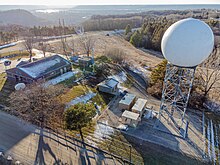
Back NEXRAD Spanish NEXRAD French NEXRAD ID NEXRAD Japanese NEXRAD Portuguese NEXRAD Russian NEXRAD Chinese
 NEXRAD Radar near La Crosse, Wisconsin | |
| Country of origin | United States |
|---|---|
| Introduced | 1988 |
| No. built | 159 in the US, Puerto Rico and Guam plus an additional 3 WSR-88Ds, one in Japan and two in South Korea that are not included in the network |
| Type | Weather radar |
| Frequency | 2,700 to 3,000 MHz (S band) |
| PRF | 320 to 1,300 Hz (according to VCP) |
| Beamwidth | 0.96° with 2.7 GHz 0.88° with 3.0 GHz |
| Pulsewidth | 1.57 to 4.57 μs (according to VCP) |
| RPM | 3 |
| Range | 460 km for reflectivity 230 km for Doppler velocity |
| Diameter | 8.54 m (28.0 ft) |
| Azimuth | 0 to 360º |
| Elevation | -1° to +20° (operations) up to +60° (test) |
| Power | 750 KW |
| Other Names | WSR-88D |
NEXRAD or Nexrad (Next-Generation Radar) is a network of 159 high-resolution S-band Doppler weather radars operated by the National Weather Service (NWS), an agency of the National Oceanic and Atmospheric Administration (NOAA) within the United States Department of Commerce, the Federal Aviation Administration (FAA) within the Department of Transportation, and the U.S. Air Force within the Department of Defense. Its technical name is WSR-88D (Weather Surveillance Radar, 1988, Doppler).
NEXRAD detects precipitation and atmospheric movement or wind. It returns data which when processed can be displayed in a mosaic map which shows patterns of precipitation and its movement. The radar system operates in two basic modes, selectable by the operator – a slow-scanning clear-air mode for analyzing air movements when there is little or no activity in the area, and a precipitation mode, with a faster scan for tracking active weather. NEXRAD has an increased emphasis on automation, including the use of algorithms and automated volume scans.